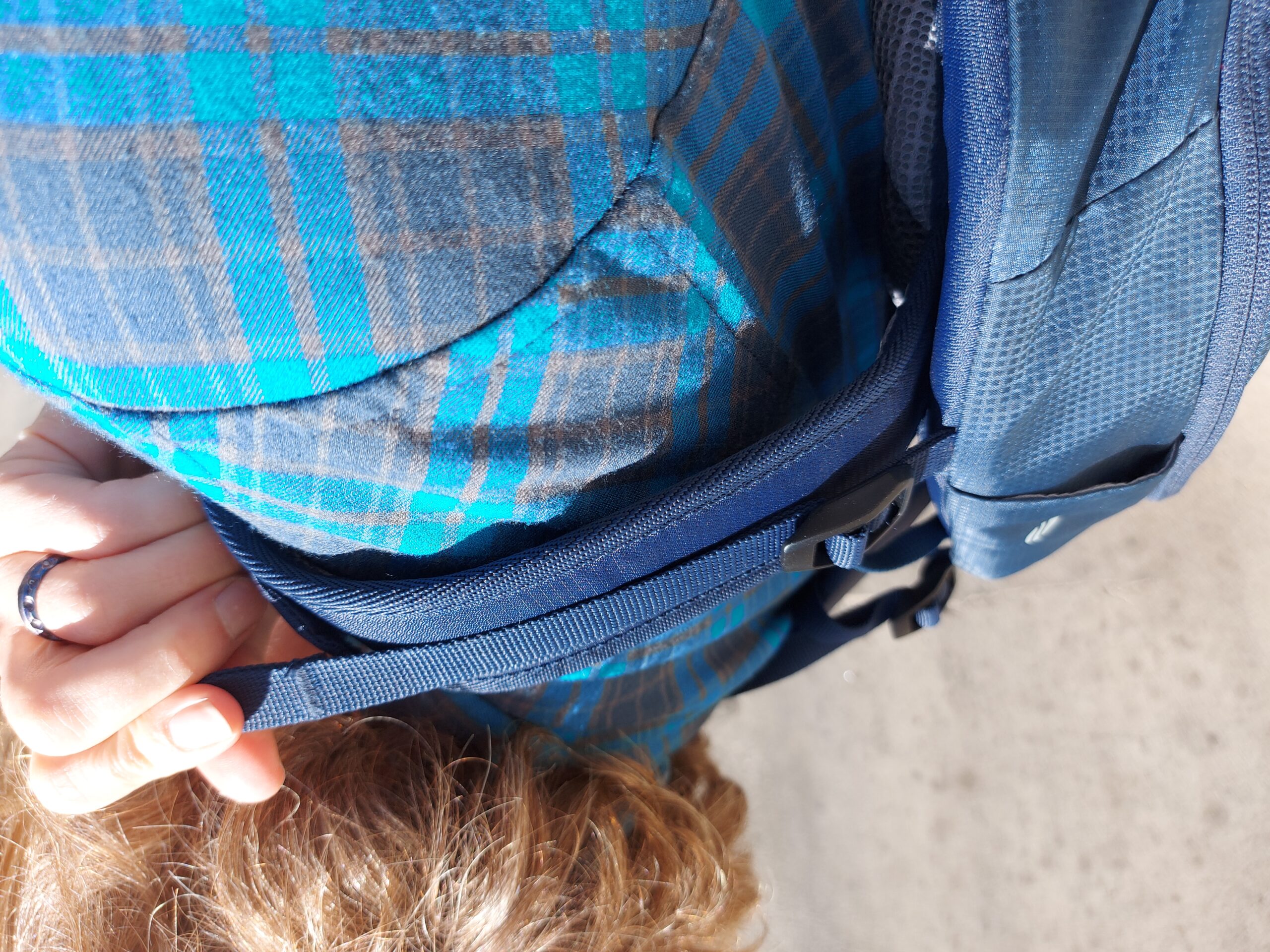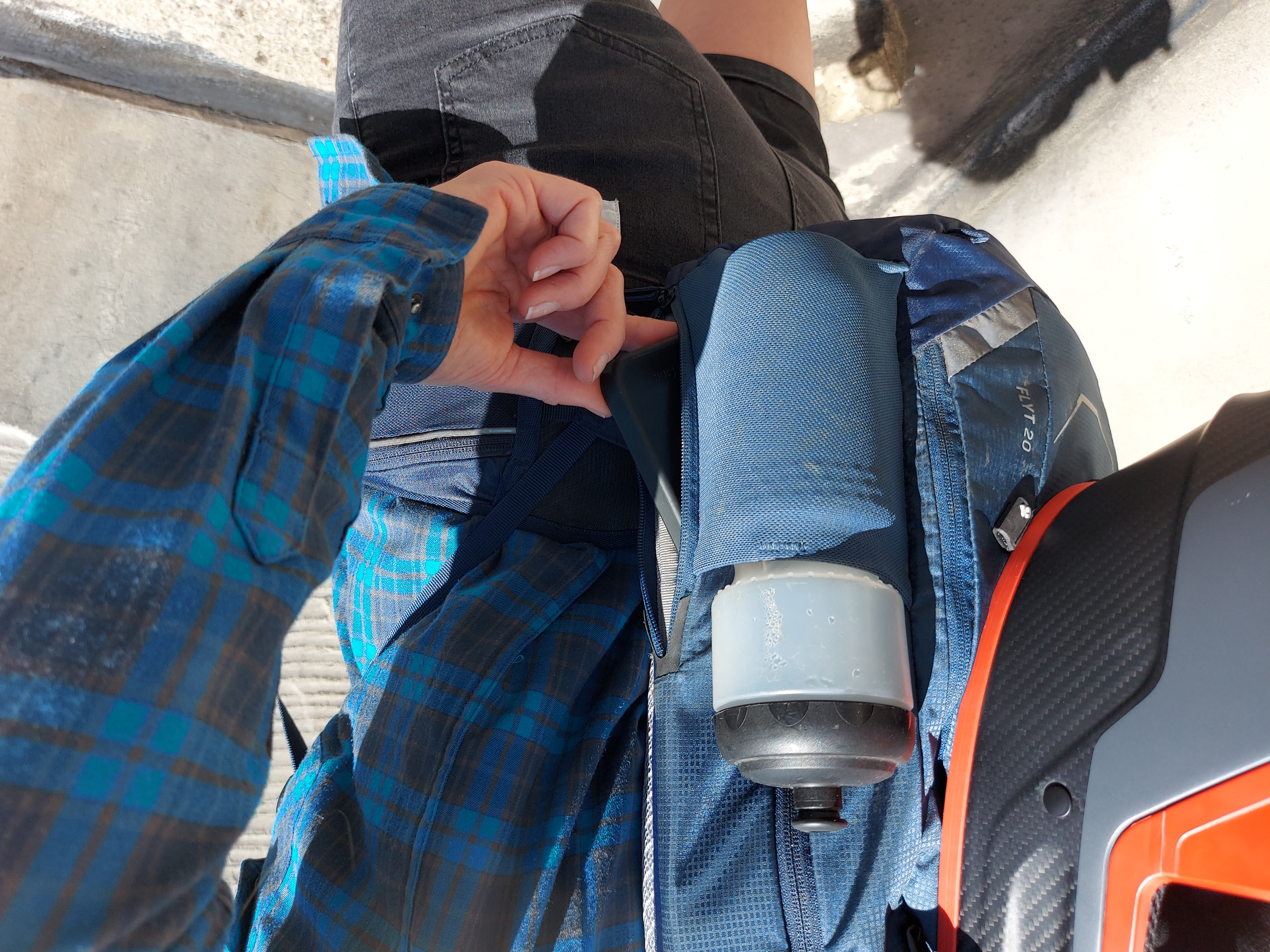The Deuter Flyt 20 backpack is a fairly lightweight backpack with integrated back protector. It seems quite a lot lighter than the Deuter Attack Enduro 16 pack that I tested previously, with fabric that feels a little thinner and a slimmed down waistband.


The front pocket of the Deuter Flyt 20 opens all the way out flat, revealing two mesh pockets and two fabric pockets with stretch tops, and a zipped pocket which runs half the depth of the bag. Unlike the Attack Enduro pack, there are no additional mesh pockets on the outer flap as it opens up, though this probably makes it easier to open the pack without losing the contents. There is no fleecy eyewear storage pocket on this pack, although one of the main shoulder straps has an elasticated loop which is meant for glasses – though that seems to me like a one-way ticket to breakage.


The main pocket opens about two thirds of the way down the length of the pack and it’s just one single large area – the only compartment in there is that which is intended for a bladder. A bladder can be routed over the left or right shoulder, but isn’t included as standard with the pack. Two outer straps with clips offer the opportunity to cinch up the pack tight, or to loop through the chin bar of a full face helmet if you want to carry one on your pack. It works OK, although there’s no retention point further down the pack to help stop a helmet from swaying side to side, and if your pack is a bit lumpy it’s tricky to get a helmet to sit neatly. You also get a basic rain cover.


On the outside edges of the bag there are two stretchy mesh pockets big enough for a bottle. The hip strap ‘wings’ are barely padded and each wing has a small zippered pocket. From the wings, a standard canvas strap with clip extends around you. There’s also an adustable chest strap, and the position of the rucksack’s shoulder straps can be adjusted top and bottom.


At the back, the ‘Airstripes’ system consists of two foam padded strips to hold the backpack away from your back. Neatly tucked away in the side of the pack next to the back protector is a phone pocket. This is nicely out of the way of any crashes and reasonably easy to access without taking the pack off, although slotting your phone in when there is a bladder in place is a little tricky. I wish the pocket fitted between the bladder and the back protector rather than the screen and the main compartment of the backpack.

The back protector is quite rigid and made of the same sort of polystyrene foam as a bike helmet would be made of, rather than D30, or Koroyd. To make sure it sits properly, the Flyt pack range comes in two sizes M-XL (Flyt 20 and Flyt 14) and S-L (Flyt 12 and Flyt 18). This M-XL is for riders 170-195cm tall, which the S-M sized packs are for riders 160-175cm tall.
On the trail
I’ve now tested quite a few backpacks with back protectors in. This one is comfortable enough and quite light, but I found it quite hard to get it to stay in place compared to others. Particularly if jumping, it has a tendency to jump up behind your head. Some extensive tightening and fiddling of the straps can reduce this effect but it is rather prone to wriggling on your back.
Although it’s got 20 litres of internal capacity, the bag doesn’t really have any outer stuffing options, so if you have a wet jacket to take off you’re going to have to put it inside in the zipped areas – there is no way to keep it separate from any dry spares you may be carrying. There’s also no obvious way to carry kneepads to the top of a climb. Those doing night rides may appreciate the reflective tabs on the rear of the bag but will likely miss the inclusion of a rear light loop attachment point.

The bag is quite slim and although it boasts a 20 litre capacity, it somehow doesn’t seem hugely capacious – I can’t say that it feels a whole lot bigger than 16 and 18 litre bags I’ve tested. I think the lack of outer stuffing options may add to this feeling. You can get everything in, but if you like to take a sandwich box on your rides you may need to do a little bag Tetris to get everything to sit neatly.
I’m not convinced this bag is a significant improvement over the Attack Enduro pack. It is somewhat lighter though doesn’t stay in place any better than the Attack Enduro with its more substantial waist strap. I often find myself using outer stuffing options on a pack, and the lack of separation opportunity for wet or muddy gear from the rest reduces the functionality in my opinion. It feels to me like the Flyt 20 sits somewhere between the Evoc Trail Pro 16, which costs a bit more but doesn’t carry a helmet, and the Camelback Chase Protector Vest, which costs a bit less, only carries 10 litres of gear, but is very good indeed. If you really need to carry more kit that 10 litres and want to carry a full face helmet, I think both the Evoc Neo Protector 16 litre and Osprey Raptor Pro 18 litre do it better, staying in place more securely (though both cost more and on paper don’t hold as much gear). All that said, if I’m carrying 20 litres of kit on my back, I’d probably place more importance on my bag staying put really well than the inclusion of back protector, and there are other large volume bags out there that I think do that better.

Overall
All in all I don’t think this Deuter Flyt 20 quite beats the other protector packs I’ve tried on functionality, although on price perhaps it does. If you need more carrying capacity than the Camelback Chase Protector Vest but don’t want to pay a whole lot for it, then this might tick your boxes.






